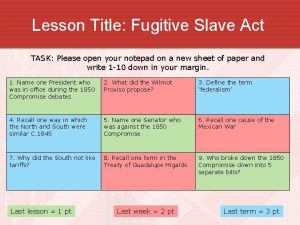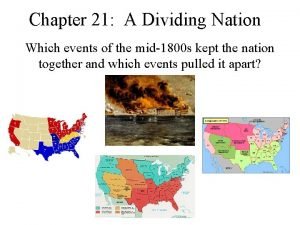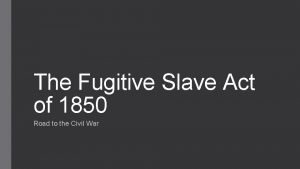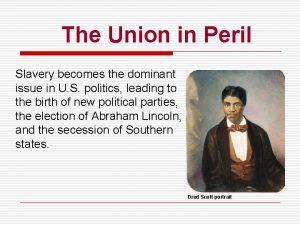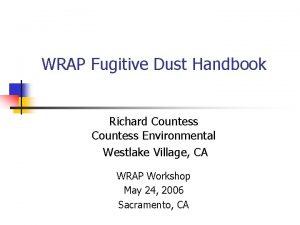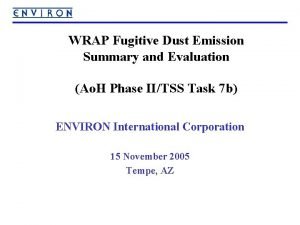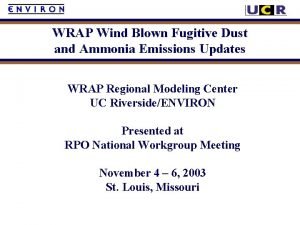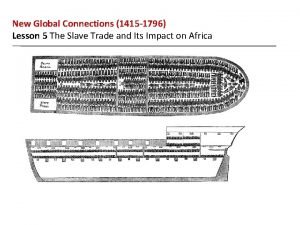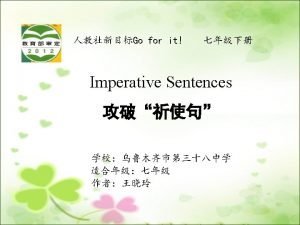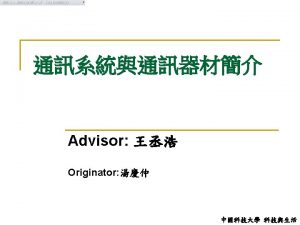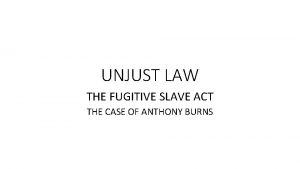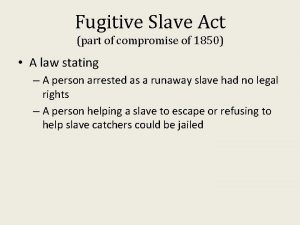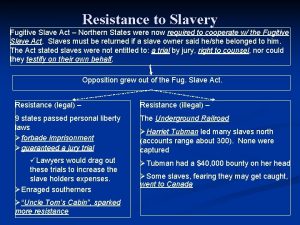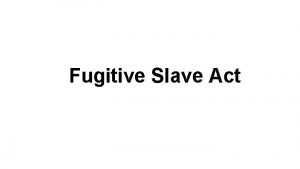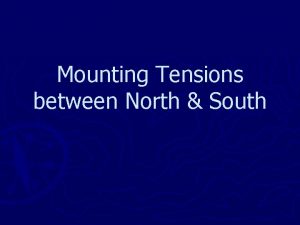Lesson Title Fugitive Slave Act TASK Please open


















- Slides: 18

Lesson Title: Fugitive Slave Act TASK: Please open your notepad on a new sheet of paper and write 1 -10 down in your margin. 1. Name one President who was in office during the 1850 Compromise debates 2. What did the Wilmot Proviso propose? 3. Define the term ‘federalism’ 4. Recall one way in which the North and South were similar C. 1845 5. Name one Senator who was against the 1850 Compromise 6. Recall one cause of the Mexican War 7. Why did the South not like tariffs? 8. Recall one term in the Treaty of Guadalupe Higaldo 9. Who broke down the 1850 Compromise down into 5 separate bills? Last lesson = 1 pt Last week = 2 pt Last term = 3 pt

Last lesson = 1 pt Last week = 2 pt Last term = 3 pt 1. Zachary Taylor OR Millard Fillmore 2. Slavery to be banned from all land acquired from the Mexican War 3. A system where there is one country made up of independent states 4. Culture, economies, political systems 5. John Calhoun; Jefferson Davis; William Seward 6. Rio Grande dispute, Polk, Texas 7. Made European goods more expensive. Europeans less likely to buy cotton. 8. Texas acknowledge as part of America; Mexican secession land, $15 million to Mexico, Rio Grande as the border 9. Stephen Douglas 1. Give yourself a score out of 18 2. In a green pen, you are going to write down which topic you need to develop you understanding of (1850 Compromise; Mexican War, America c. 1845) 3. For next lesson you need to create revision material on that topic. In that next lesson, you will be given a new quiz just on the topic you are revising.

Topic: Fugitive Slave Law (1850) Based on the topic. EXPLAIN above, discuss on your table: JUDGE KNOW The different reactions How far the Fugitive The • keywhat details of you think will. Slave be covering this lesson to thewe Fugitive Slave law created tension the Fugitive Slave Law • (1850) what we will be expected to know by the endand between North Law South

Laws concerning Fugitive Slaves https: //www. youtube. com/watch? v=Jk. HK 8 q. Dr. TTM Use the following sides to: • Give each law a mark /10 based on how strict it is • Explain why either in the bar or below your graph How strict is the law? 10 5 0 Constitution (article 4) 1793 FSL Prigg v. Pennsylvania 1850 FSL

United States Constitution: Article IV, Section 2, Clause 3 • No person held to service or labour in one state, under the laws thereof, escaping into another, shall, in consequence of any law or regulation therein, be discharged from such service or labour, but shall be delivered up on claim of the party to whom such service or labour may be due.

Fugitive Slave Act 1793 1. Authorized local governments to seize and return escaped slaves to their owners 2. Imposed a $500 penalty on anyone who aided runaway slaves in their flight.

Prigg v. Pennsylvania (1842) • The Supreme Court declared a slaveholders right to his property overrode any contrary state legislation… but! • States did not have to offer aid in the hunting or recapture of slaves.

Fugitive Slave Act 1850 1. Federal Marshalls to raises posses to pursue fugitives on northern soil. Those who refuse to join risked a $1000 fine. 2. Federal Commissioners could determine the fate of alleged fugitives without a jury trial or testimony. (slavery more important than states rights? ? ) 3. Not just recent runaway slaves, but those that had escaped in the decades previous 4. Any person aiding a runaway slave by providing food or shelter was subject to six months' imprisonment and a $1, 000 fine

Reactions to the Fugitive Slave Law • You have been given a series of hexagons that outline different reactions to the Fugitive Slave Law. They can be categorised into three groups within American society. What different groups existed in America Society in 1850? EXPLAIN the different reactions to the Fugitive Slave Law

Reactions to the Fugitive Slave Law • You have been given a series of hexagons that outline different reactions to the Fugitive Slave Law. They can be categorised into three groups within American society. TASK 1: Sort the cards into three groups, based on similarities in their reaction to the Fugitive Slave Law TASK 2: Decide what group in society each category is and then stick them onto your A 3 paper. CHALLENGE: Do these reactions give you a full picture of reactions to the Fugitive Slave Law? Justify your answer. EXPLAIN the different reactions to the Fugitive Slave Law

Slaves Used underground railroads - network of secret routes and safe houses used to help flee into Canada. 3000 moved to Canada in last 3 months of 1850 A slave named Margaret Garner, killed her daughter to prevent her from being returned into slavery. EXPLAIN the different reactions to the Fugitive Slave Law

Abolitionists An owner who tried to recapture his slave was killed in Pennsylvania. A newspaper reported: ‘Civil War – the first blow struck’ A large crowd helped to rescue escaped slave Jerry from jail in Syracuse, New York. The Fugitive Slave Law (1850) appalled this group 1854: Boston mob broke into a courthouse and killed a guard in an attempt to rescue fugitive slave Anthony Burns. (The people of Boston later purchased Burn’s freedom). Aided fugitive slaves by violently resisting recapture. William Lloyd Garrison: ‘‘The only way to make the Fugitive Slave Act a dead letter, is to make half a dozen or more dead kidnappers’ EXPLAIN the different reactions to the Fugitive Slave Law

Moderate Northerners 9 states passed "personal liberty laws” mandating a jury trial before alleged fugitive slaves could be sent back into slavery. Vigilance committees sprang up in many Northern communities. (Groups of private citizens to administer the enforcement of the Fugitive Slave Law). Other northern states forbade the use of local jails or the assistance of state officials in the arrest or return of alleged fugitive slaves. Accept the Fugitive Slave law as the price they had to pay to save the Union The act contained a number a features which were distasteful to this group In some cases, juries refused to convict individuals who had been accused under the Federal law. EXPLAIN the different reactions to the Fugitive Slave Law

Balance… • Overt resistance should not be exaggerated. The south and abolitionists exaggerated to amount of resistance. In most northern states the Fugitive Slave Law was enforced. EXPLAIN the different reactions to the Fugitive Slave Law

Review: Fugitive Slave Law (1850) Give a mark out of 10, based on how much tension you think the Fugitive Slave Law (1850) caused. Be prepared to explain your mark Explain 2 reactions to the Fugitive Slave Law (1850) Recall 3 facts about laws concerning Fugitive Slaves

Flipped Learning • Read the handout you have been given on Abolitionism • Highlight 10 key points in the article about the growth of abolitionism in the North • Star what you believe are the 3 most important points DUE: Next America lesson

To what extent did the Fugitive Slave Law (1850) increase sectional tension? • https: //www. youtube. com/watch? v=Jk. HK 8 q. Dr. TTM Small Extent Write one sentence that makes your answer to the question clear. Write sentences that contain relevant, accurate and detailed evidence. Use the knowledge you have just recalled to explain why your opinion is right and justified. Large Extent Write one PEE paragraph that explains your answer to this question. DECIDE how far the Fugitive Slave law created tension between the North and South

To what extent did the Fugitive Slave Law (1850) increase sectional tension? Write one sentence that makes your answer to the question clear. Write sentences that contain relevant, accurate and detailed evidence. Use the knowledge you have just recalled to explain why your opinion is right and justified. Peer Assessment 1 point – if your partner makes a clear point in their first sentence about what there opinion is on this topic. 2 points – if your partner uses detailed evidence that covers more than one group in American society. 3 points – if your partner explains why the evidence justifies the level of tension outlined in sentence one. DECIDE how far the Fugitive Slave law created tension between the North and South
 Fugitive slave act summary
Fugitive slave act summary Chapter 21 a dividing nation answer key
Chapter 21 a dividing nation answer key Fugitive slave act worksheet
Fugitive slave act worksheet Fugitive slave act
Fugitive slave act Wrap fugitive dust handbook
Wrap fugitive dust handbook Wrap fugitive dust handbook
Wrap fugitive dust handbook Wrap fugitive dust handbook
Wrap fugitive dust handbook 영국 beis
영국 beis Title act interior design
Title act interior design Nobody said anything raymond carver
Nobody said anything raymond carver Lesson 5 the slave trade and its impact on africa
Lesson 5 the slave trade and its impact on africa Tiered task bias task
Tiered task bias task Macbeth act 3-5 summary
Macbeth act 3-5 summary Be quiet guys
Be quiet guys Hello please open
Hello please open Completing reports and proposals
Completing reports and proposals Title title
Title title Open source distributed job scheduler
Open source distributed job scheduler The teacher said to the students, “please be silent.”
The teacher said to the students, “please be silent.”
